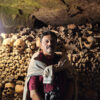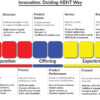Surgical mastery is 75 percent Mindset, 25 percent handwork!
Why do we need innovative learning methods?
The truth is no matter how successful surgeons we become, there is always another level or something we haven’t learned or mastered. This is more so with specialities like Otorhinolaryngology, which are vast. And no matter how much we grow, there will always be something we struggle with.
“We get stuck in a surgical entrepreneurial hamster wheel if we aren’t constantly learning!” thus spake PNB.
Going back to Christopher Nolan’s Inception Scene: PENROSE STEPS
ARIADNE: Architecture?
Arthur leads Ariadne down some busy steps in a large glass and steel atrium in an office complex.
ARTHUR: You’re going to have to master a few tricks if you’re going to build three complete dream levels.
A SECRETARY DROPS some papers as they pass…
ARIADNE: What sort of tricks?
They take a tight turn and continue down the next flight.
ARTHUR: In a dream, you can cheat architecture into impossible
shapes.
ARTHUR (CONT’D): That lets you create closed loops, like the Penrose Steps. The infinite staircase.
Ariadne FREEZES- THEY ARE IN THE EXACT SPOT THEY STARTED DESCENDING FROM, next to the Secretary gathering her papers.
Ariadne puzzled at the impossible construction of the stairs.
ARTHUR: See…
Arthur stops her gently- they are on the highest step, with a LARGE DROP to the next step. Arthur gestures at the drop.
ARTHUR: Paradox. A closed-loop like this helps you disguise the boundaries of the dream you’ve created.
ARIADNE: How big do the levels have to be?
ARTHUR: Anything from the floor of a building to an entire city.
In my earlier blogs, I emphasised the deconstruction of surgical steps. However, mental construction or reconstruction of the surgical process is equally important. A surgical procedure is similar to architecture. We start with investigations. Next, we do pre-surgical planning based on a solid foundation of basics. Finally, we perform the surgery or anatomy’s construction, reconstruction, modification, or dismantling. How can we trick our minds into learning the surgical process faster using this deconstruction-reconstruction model?
One of the key techniques is sketch-boarding. Sketch-boarding is drawing diagrams, making notes, adding images or screenshots to reconstruct the surgical steps. Sketch boards may appear kids-stuff, but makes mastering surgeries simple, fun and intuitive. We don’t have to be Raja Ravi Verma to draw diagrams. More abstract, the better!
When we draw, we should go to multiple levels. We should be able to mentally or on a sketch board, construct the entire procedure. I draw three levels—first, the basic steps. Second, technical aspects of each step. And the third is fine-tuning for execution.
When you develop the habit of drawing, you start dreaming about it. If you dream it, soon it will become a reality. It creates a mindset for mastery. Surgical mastery is 75 percent Mindset, 25 percent handwork. More to come on sketch boarding.
Prof. Dr. Prahlada N.B
Chitradurga
9 February 2022

















Leave a reply